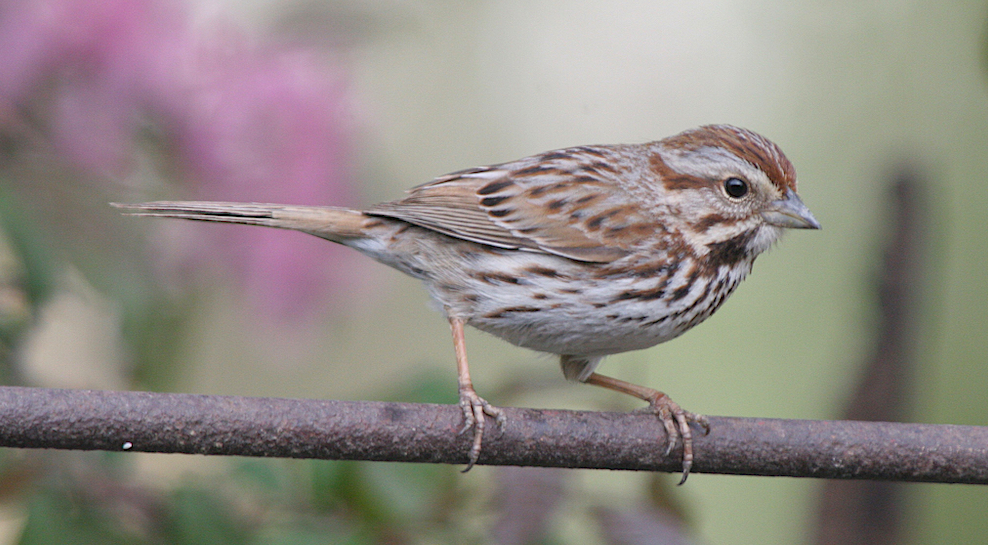BY KIERAN LINDSEY, PhD
A scientists’ work is never done.
That’s because there’s always another layer to peel away, another stone to turn, another angle from which to view the situation. Case in point — about 200 years ago, Charles Darwin made the connection between the size and shape of a finch’s beak and the availability of the seeds they eat and, to this very day, no one has produce evidence that undermines his observation and the conclusions he drew from them.
But what if there’s even more to a beak than meets the eye?

That’s the question raised by Russell Greenberg of the Smithsonian Conservation Biology Institute. His theory—that beak size may also be an adaptation to temperature regulation and water conservation—has been bolstered by study data (collected, in part, by a member of my own extended family, St. Louis native Dr. Ray Danner, who is now a member of the UNC-Wilmington faculty).
Greenberg noticed a difference in size between the beaks of sparrows living in salt marshes and those of sparrows settled just a kilometer or two further inland. Then a 2009 paper reported toco toucans (Ramphastos toco) may lose as much as 60% of their body heat through their long bills, based on thermal imaging, and similar to the role played by the large ears of both elephants (Elephantidae) and jackrabbits (Lepus spp.). While many ecologists assumed toucans were a special case, Greenberg wondered—might other birds have evolved larger or smaller beaks to discharge or conserve heat as well?
He chose to test his hypothesis by applying thermal imaging to a subject with a much less prominent proboscis—the Song Sparrow (Melospiza melodia). Native to North America and a resident of Lafayette Park from autumn until early spring, everything about these feathered minstrels is miniature compared to their distant South American kin — the toucan weighs in at 1-2 pounds (the large bill doesn’t actually tip the scale as much as you might expect because it’s mostly hollow) while at 0.4—1.9 ounces the Song Sparrow is definitely a featherweight.

In Greenberg’s first study, two subspecies were examined. On average, the beak of an Atlantic Song Sparrow was found to have 17% more surface area than that of the Eastern Song Sparrow, although both birds have similarly sized bodies. Based on the research team’s calculations, the Atlantic loses 33% more heat than it’s inland neighbor. The finding suggested beaks may play a role in thermoregulation for a wide variety of bird species.
The ability to stay cool when ambient temperatures rise is critical to survival, but how one gets rid of the excess heat is just as important. Birds don’t sweat. Like dogs, they pant… and lose not just heat but water in the process, and water is an particularly precious resource for any creatures without easy access to a faucet. Greenberg and his team suggest that a bird’s beak can function like a radiator, releasing heat without losing water. The Atlantic Song Sparrow’s larger bill saves the bird about 8% more water than the smaller beaked Eastern Song Sparrow. That may not sound like much but during a hot, dry summer it could be a significant survival advantage.

Greenberg’s second study examined museum specimens of Song Sparrows collected on the other side of the continent, along the California coast. Sure enough, as maximum temperatures increase, so did beak size… with one caveat — when the maximum average temperature was greater than 98°F (37°C) beaks got smaller… but that was predicted by the original hypothesis. You see, if you took a Song Sparrow’s temperature the thermometer would read about 105°F (41°C). When the air temperature exceeds the bird’s own temperature, as it does in some regions, a larger beak could actually begin to absorb heat rather than release it.
While the Smithsonian group demonstrated a connection between climate and beak size, there’s still plenty of work to be done. For their hypothesis to garner support, scientists need to see data that ties survival of other wild bird species to beak size-related heat dissipation.
Meanwhile, our understanding of the connection between diet, beak size, and beak shape hasn’t changed — Darwin can continue to rest in peace. But as so often is the case, the more we discover the more we realize just how rich and complex this world and its inhabitants are … even an Earthling as seemingly plain and simple as a Song Sparrow.


